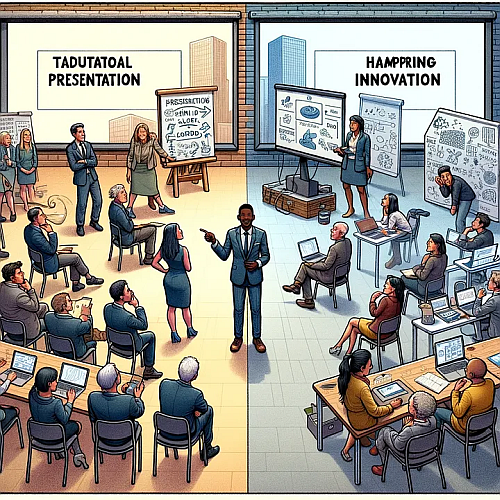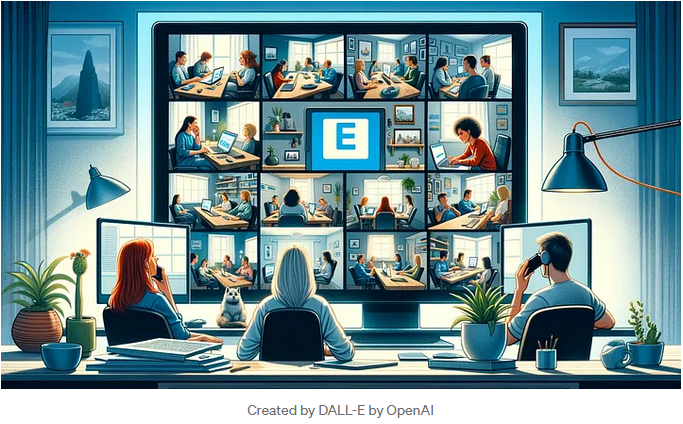Thank you to Kem-Laurin Lubin, PH.D - C for sharing her knowledge and expertise with us.
You can read this article on Medium

“PowerPoint presentations too often resemble a school play — very loud, very slow, and very simple.” — Edward Tufte
Remember the days when asking someone to share their presentation almost felt like an apology? Like you were subtly borrowing their ideas without saying it. Now, it’s a whole different ball game. PowerPoint has become the go-to in the business world. It’s like we’ve decided that no conversation is complete without a PowerPoint in the background. Kind of normalizes the idea that we need these slides to communicate, doesn’t it?
Throughout my extensive career, I’ve been lauded for my creativity and knack for efficiency and great communications. Yet, most recently, I’ve found myself amidst a sea of individual types who are fixated on condensing every idea into PowerPoint slides, most often destined for the digital catacombs of their company’s document management system. These slides, more often than not, end up as forgotten relics, occasionally plundered for a slide or two, then abandoned.
As someone whose roots are more aligned with the no-nonsense, visual-frill-free environment of an engineering department, this trend irks me. It’s like watching my creativity and innovative spirit being slowly asphyxiated.
Most times, it’s painfully clear: someone’s ignorance turns into a pointless task for a bored and ignorant audience of one. This audience one, more often than not, is just a parrot, mindlessly echoing things they don’t even grasp. PowerPoint has morphed into a crutch, a set of cue cards for speakers to jog their memory.
Nowadays, it’s nothing more than a tool for others to hijack and regurgitate someone else’s effort. But let’s not dwell on this soul-sucking facet. Instead, let’s talk about the irony: PowerPoint, meant to aid communication, has become a roadblock to genuine innovation
In this blog, I delve into the irony of captivating audiences with PowerPoints and the fundamental implications of this trend. With the corporate world’s pivot to online operations and the rise of remote working, this issue has become more pressing. From a personal standpoint, my own engagement wanes when faced with the endless cycle of the same ideas being recycled in slide after slide.
This monotonous merry-go-round cultivates a hearty dose of apathy towards communication as a whole.
The PowerPoint paradox: Standardization vs. innovation in business presentations
For two decades, my professional journey rarely crossed paths with PowerPoint. Ideas birthed in my mind found their direct way to JIRA, a platform where development and design seamlessly intertwined. The landscape, however, is shifting for many designers. Today, they find themselves entangled in the tendrils of PowerPoint, a tool that often draws their ire. This shift can be partly attributed to the growing trend of integrating Design and Customer Experience (CX) teams under the umbrella of Marketing departments. Tools like Mural and Miro have emerged as alternatives, yet they haven’t fully replaced the PowerPoint hegemony.
This trend is not just a deviation but a worrying pivot for many designers. Their primary audience has always been tech and engineering teams, with whom they collaborate closely to steer projects towards fruition. PowerPoint presentations were occasional, reserved for showcasing work, not a constant companion. Now, many designers feel ensnared in a cycle of ‘make work’ — creating content for audiences they never intended to cater to.
“A man who cannot walk leans on a crutch for support, just as one who cannot speak his own words relies on PowerPoint to express his thoughts.” -Author
Today, PowerPoint has become the de facto standard for presentations. It is the preferred medium for pitching ideas, sharing insights, and communicating messages across various industries. Despite its widespread use, this ubiquity might actually be detrimental, particularly in the context of fostering innovation and creativity. The format of PowerPoint, with its reliance on bullet points and slide sequences, inherently limits the expression of ideas. This structure often restricts the narrative to a linear, rigid progression, leaving scant room for dynamic, interactive storytelling or the exploration of complex, multi-faceted concepts.
The result is often a ‘checkbox’ mentality, where the emphasis shifts from the substance and quality of the content to the task of populating slides with buzzwords, graphs, and other typical elements. This approach can lead to an over-simplification of ideas, where potentially ground-breaking concepts are distilled down to fit within the confines of a PowerPoint template. In the process, the richness and nuance of these ideas may be lost, reducing them to mere shadows of their original potential.
Moreover, this reliance on a standardized format risks turning presentations into forgettable, formulaic slide decks. When every presentation follows the same structural blueprint, the unique qualities of each idea become muddled. This homogenization can dampen enthusiasm and engagement, both for the presenter and the audience, as each deck starts to look like the last.
In this environment, the potential for truly novel and revolutionary ideas is often curtailed. The constraints imposed by traditional PowerPoint formats may inadvertently discourage presenters from experimenting with unconventional structures or narrative styles that could more effectively convey their innovative concepts. As a result, opportunities for genuine breakthroughs in thought and application may be missed, reinforcing a cycle of conformity and mediocrity in business communications.
This situation calls for a re-evaluation of how we use tools like PowerPoint in the business context. It challenges us to rethink our approach to presentations, aiming for methods that encourage creativity, foster engagement, and allow for the full breadth and depth of innovative ideas to be explored and appreciated.
Illusions of insight: Decoding the jargon-filled world of PowerPoint
PowerPoint presentations are frequently saturated with jargon that seems impressive but often lacks substance. Common terms like “synergy,” “paradigm shift,” and “leverage” are liberally employed, giving an air of sophistication without always delivering real value. These presentations typically feature slides crowded with acronyms such as “KPIs” (Key Performance Indicators) and “ROI” (Return on Investment), which are paired with a plethora of financial charts — bar graphs, pie charts, and scatter plots — that are more ornamental than analytical.
Additionally, buzzwords like “strategic alignment,” “core competencies,” and “value-added” are heavily sprinkled throughout these presentations. This use of trendy language creates a facade of depth and insight, yet often conveys minimal practical information. This overuse of business speak, often borne in MBA programs, can be more about showmanship than actual strategy or meaningful content.
Furthermore, these presentations can be riddled with overly complex models and frameworks that obscure more than they clarify. Complex diagrams and flowcharts, often filled with interconnecting arrows and boxes, can make the content seem more profound than it is, leading the audience through a maze of convoluted thoughts and ideas.
The use of such elements can serve to dazzle rather than enlighten, leaving the audience with a sense of being informed while actually providing little in the way of actionable insights or clear understanding.
A people leader I spoke with recently expressed frustration over this trend, describing these presentations as mere theatrics. She found them counterproductive and even antagonistic to her repeated requests for straightforward, meaningful PowerPoint presentations. Her experience underscores a growing sentiment in the business world: the need for more substance and less fluff in corporate communications. This raises important questions about the effectiveness of current presentation practices and the genuine value they bring to business discussions.
The PowerPoint template trap
The core issue with PowerPoint lies in its template-driven approach. While templates provide convenience and a sense of uniformity, they also come with inherent limitations. The typical PowerPoint format — a succession of slides adorned with bullet points, charts, and images — fosters a linear and compartmentalized mindset. This rigid structure inherently restricts the complexity and depth of ideas that can be conveyed, nudging presenters towards oversimplification or, worse, neglect of the more nuanced facets of their subject matter. Consequently, this approach can truncate the full potential of a presentation, reducing rich, multifaceted topics to mere shadows of their true complexity.
The illusion of understanding
PowerPoint’s focus on concise, bullet-pointed content often gives rise to an illusion of understanding. By distilling complex ideas into digestible snippets, it inadvertently promotes a shallow grasp of the subject matter. Such simplification is especially harmful when it comes to grasping innovative concepts, which necessitate a thorough comprehension of intricate details and interdependencies. The format’s tendency to skim the surface can, thus, mask the need for deeper exploration and critical thinking, leading to a superficial engagement with potentially transformative ideas. This can result in significant nuances being glossed over, and the true essence of complex concepts being lost in translation.
The creativity conundrum
Creativity flourishes in spaces that allow for fewer restrictions and embrace free-flowing thought. Unfortunately, PowerPoint, with its inherent rigidity, often stifles such spontaneity. The emphasis inadvertently shifts from the intrinsic value of an idea to how conveniently it can be molded to suit a slide format. Consequently, this can lead to the premature dismissal of unconventional ideas that don’t conform neatly to the standard PowerPoint template. Such a framework can inadvertently sideline creative thinking, favoring ideas that are easier to package and present over those that might be more innovative but less immediately presentable within the constraints of a slide deck.
The impact on audience engagement
PowerPoint presentations can inadvertently result in a passive form of audience engagement. The predictable progression of slides, combined with an over-dependence on visual aids, can make it difficult to maintain the audience’s interest. This kind of passive consumption of information is detrimental to the kind of lively, interactive discourse that is essential for nurturing innovative ideas.

When audiences are merely spectators, rather than active participants in a discussion, the opportunity for collaborative thinking and the exchange of ground-breaking ideas is significantly diminished. This can ultimately stifle the potential for innovative outcomes that arise from engaging and dynamic interactions.
Alternatives to PowerPoint
To counteract the constraining impact of PowerPoint on innovation, exploring alternative approaches to presentations and idea sharing is essential. Some promising alternatives include:
Storytelling
Employing narratives to communicate ideas can be far more engaging and memorable. This approach taps into the human affinity for stories, making complex concepts more relatable and easier to understand.
Whiteboard Sessions
These sessions foster an environment of free-form thinking and real-time collaboration. They encourage spontaneity and the organic development of ideas, moving away from the pre-structured format of PowerPoint.
Interactive Workshops
Facilitating hands-on experiences where participants can collectively explore and develop ideas. Such workshops not only engage but also empower attendees to contribute actively, fostering a more collaborative and innovative environment.
These methods can invigorate meetings and discussions, moving away from the static nature of traditional slide presentations to a more dynamic and participatory form of idea exchange. And no these sessions do not require a summary PowerPoint.
While PowerPoint is a valuable tool for certain types of communication, it’s crucial to acknowledge its limitations, particularly in the realm of fostering innovation. Escaping the confines of standardized presentations and delving into more dynamic and interactive methods might just be the catalyst needed to unleash heightened creative potential and propel forward-thinking ideas. Embracing a variety of approaches not only diversifies the way information is conveyed but also enriches the ideation process, allowing for a more holistic and robust exploration of innovative concepts. This shift could mark a significant step towards a more engaged, collaborative, and inventive approach to problem-solving and idea generation in the corporate world.

About me: Hello, my name is Kem-Laurin, and I am one half of the co-founding team of Human Tech Futures. I am currently pursuing a doctoral degree at the University of Waterloo, ON, Canada. My research inquires into identity construction through contemporary case studies (judicial) that demonstrate how citizens’ data is collected and utilized. Whether data is illicitly harvested or willingly shared, the resultant algorithmic constructions wield immense power over users whose identities are quantified through information. My research objectives are to (1) develop a critical understanding that will then allow me to (2) produce concrete heuristic principles for use in AI powered design systems (as informed by my professional experience in systems design).
Professionally I practice as a Principal HCD Strategist and Design Thinking Coach. Prior, I led both small and large Design and Research teams at Blackberry Autodesk and also worked at Siemens in both Munich, German, Princeton, USA. In my spare time, I build layered gardens with a tropical vibe while my 135 pound GSD looks on. Today I feel blessed to have traveled to over 25 countries before the world transformed to what it is today; I was able to experience a good breadth of human experiences. Periodically, I give back as an active mentor to my students, and many burgeoning critically thinking HCD Researchers who seek to make the world a better place.*